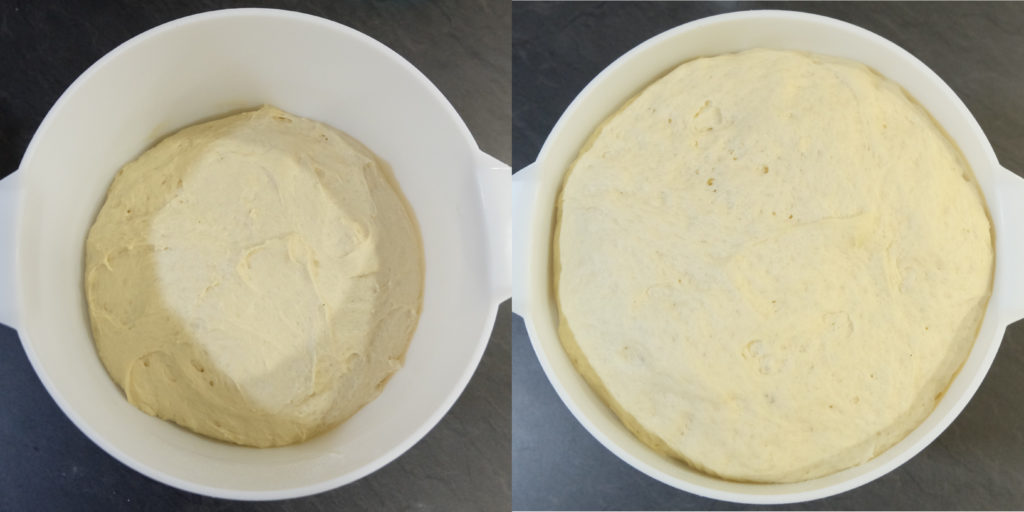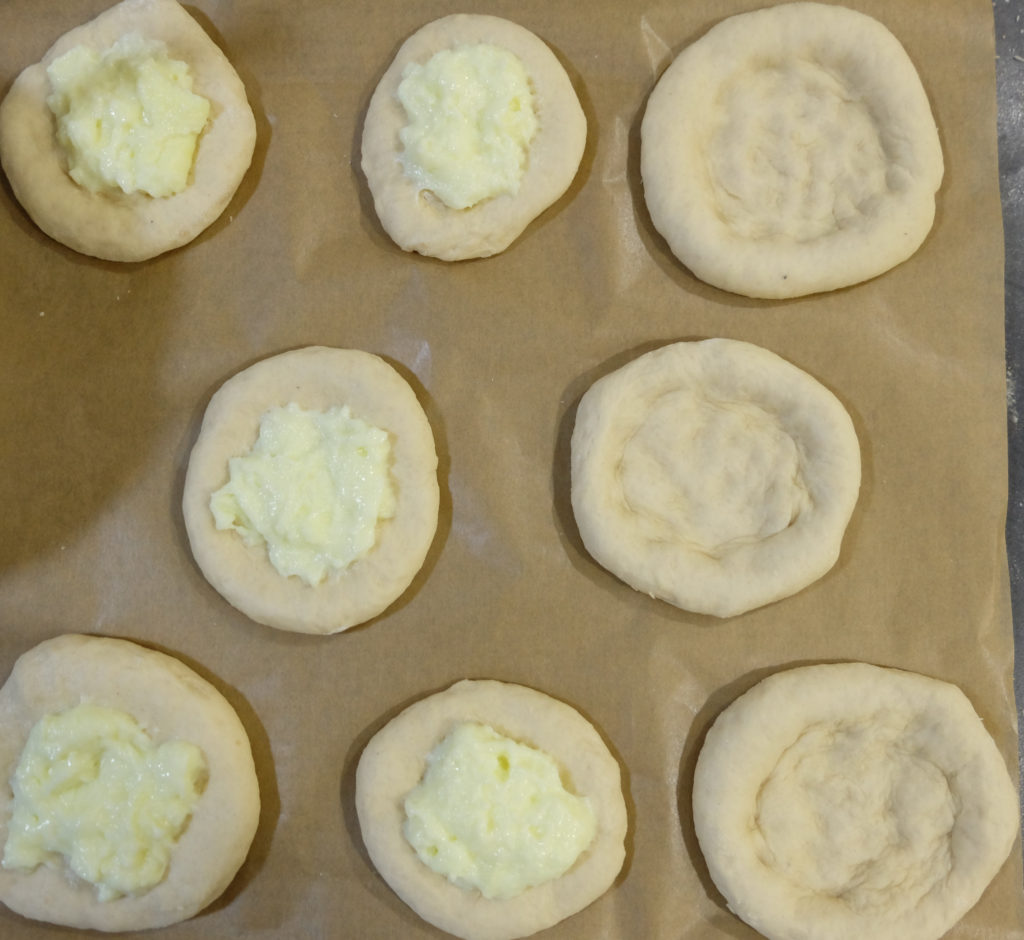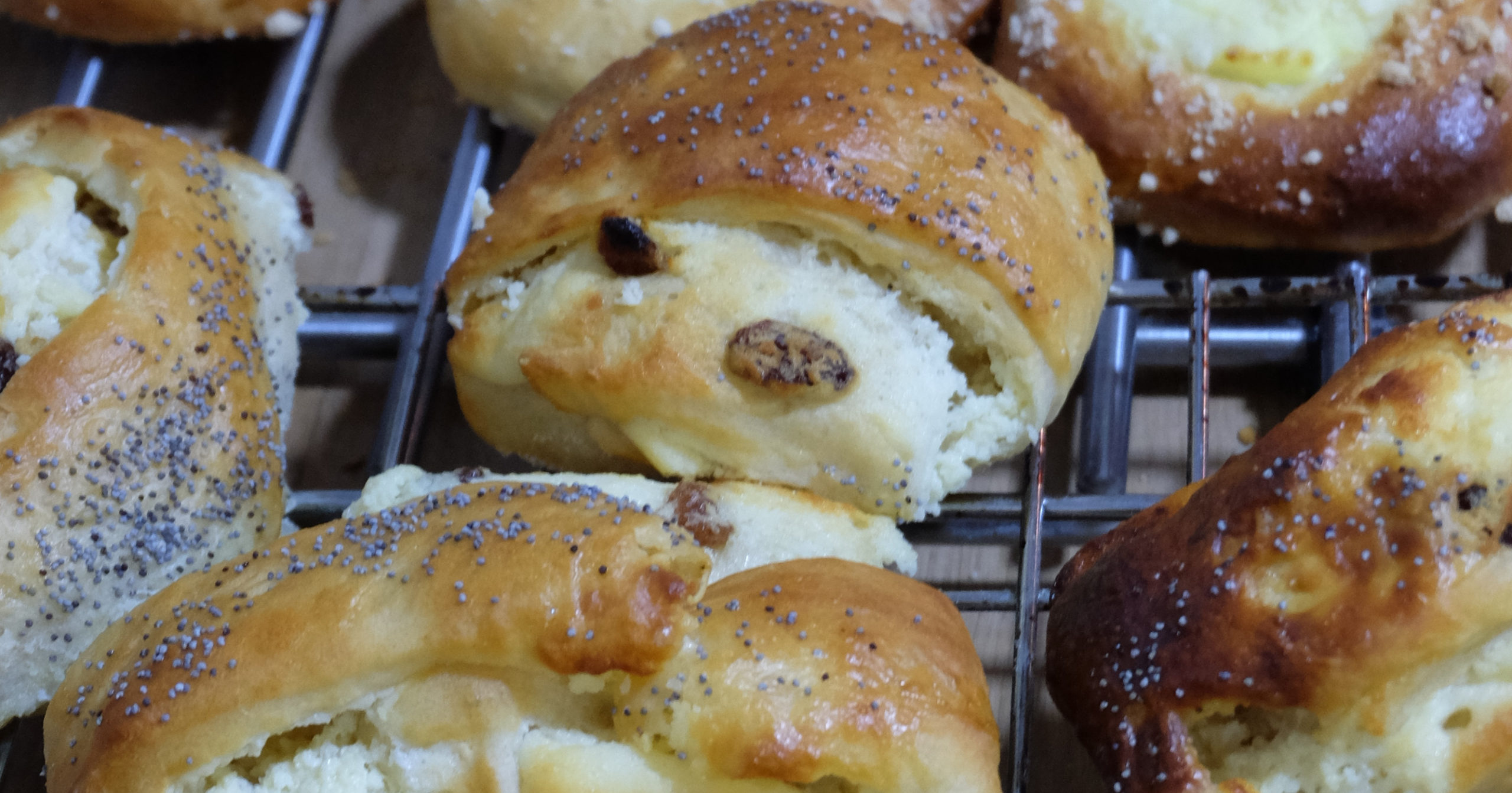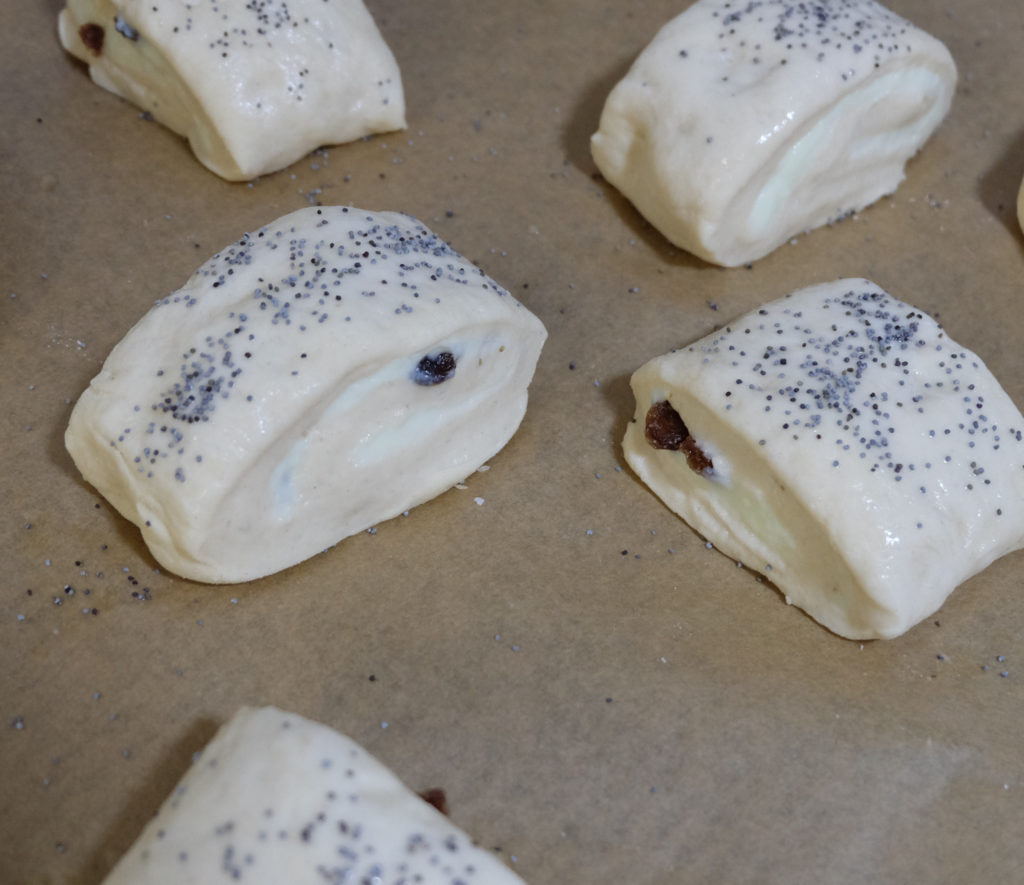Grace, a friend of ours, has asked us if we had a recipe for drożdżówki. Well, now we do.
Grace, nasza przyjaciółka, zapytała nas czy mamy przepis na drożdżówki. Teraz już tak.
We like being asked for something specific. One reason is because it’s a great source of inspiration, another because it’s a great feeling when people come to you and see you as a source of good recipes.
We met Grace because of a linseed. Baking a lot of bread means a lot of seeds, and I tend to mess the orders up from time to time. We ended up with a couple kilograms of just organic linseed that had just expired – totally fine for home use. I published it on Olio, a very interesting app that helps us reduce waste. Grace’s daughter got in touch and Grace came to pick it up. We ended up exchanging contacts. A couple days later Grace sent as pictures of bakes from the Mielnik Bakery in Poland, including drożdżówki, asking for the recipe.
Drożdżówka (pronunciation from Google Translate) is a sweet bun, usually with some sort of filling. The variants I recall are:
- cheese,
- blueberries,
- strawberries,
- pudding,
- plums,
- jam,
- poppy seeds
- crumble
I’m sure I missed a couple here. It comes in a whole range of shapes and sizes.
I decided to go for ones with cream pudding and cheese.
Now you can call me an ignorant but I just don’t know if a pudding powder is easily available. It is in Polish stores. So is twaróg, Polish white cheese. I recommend you go to a Polish store to get them, ask for budyń without sugar (booddin) and fat or semi-fat twaróg (tvah-roog). The staff will understand.
Depending on which option you choose, you may need to adjust your ingredients – I provide the quantities of filling for the whole amount of dough. If you want to use both, halve the portions or double the dough amount. But it will be a lot of dough.
Recipe sources:
- The dough, the pudding: Przyślij Przepis
- Cheese filling: Domowe wypieki
- Crumble: Beata Śniechowska
Planning
You will have to take things out of the fridge before baking. I really recommend having all ingredients in room temperature. Let’s say this will be 30 minutes before at minimum. You can do it much earlier, of course.
Dissolving yeast: 15-20 minutes; dough mixing: 5-15 minutes; dough rising: varies, let’s say 60-90 minutes; shaping: 5-10 minutes; final rise: 5 minutes; baking: 20 minutes. Together: 2-3 hours.
Ingredients
Makes around 16 buns. The author of the original post made 18. Splitting the dough into 8 equal portions is simpler than splitting to 9, so 16 is the number.
The dough
- 500 g plain flour
- 50 g fresh yeast (I wound use 30-40 next time)
- 60 g sugar
- 100 ml milk
- 1/2 tablespoon of vanilla extract
- 1 egg
- 175-200 g natural yoghurt
- 50 g rapeseed oil
- 1 flat teaspoon salt
- an egg white for glazing the dough
- optionally some poppy seeds to sprinkle on top
Pudding filling
I buy the powder in Polish stores. This recipe assumes you have one without sugar in it. Be aware this is for the whole batch of 18 buns.
- 250 ml + 125 ml milk
- 1 package of pudding without sugar, this box had 35 g in it (I used cream flavour, orignally it was vanilla; chocolate should go well too)
- 20 g sugar
- a handfull of rasins or berries (not essential)
Cheese filling
Just make sure the cheese has high fat content (tłusty). Be aware this is for the whole batch of 18 buns (or even more). I originally adjusted this recipe to the size of a cheese packaging (500 g). It was way too much filling.
- 300 g twaróg
- 30 g soft butter
- 80 g sugar
- 2 egg yolks
Crumble
This may still be too much (I halved the quantities compared to what I used). If so, you can use the rest to make biscuits or a cake. Or freeze it.
- 100 g plain flour
- 50 g soft butter
- 50 g icing sugar
Preparation
- Take the milk, crumble yeast into it, add a tablespoon of the flour (from the weighted amount) and mix for about 5 minutes until it makes a runny mixture. Leave to get active for about 15 minutes. It should then form bubbles on the surface
- Put all the dough ingredients in a bowl and mix to form the dough. I am lazy, I used a dough hook in a mixer for about 5-8 minutes. Mixing by hand will take more time. Make sure all ingredients are incorporated. If mixing by hand, leave the oil as the last ingredient to add. Leave the dough for 60-90 minutes – this should be enough for it to double its volume. I let my dough triple the volume and it was overproofed when I used it

The dough - Time for the pudding: heat 250 ml of the milk and sugar in a sauce pan. In the meantime disolve the powder in remaining milk. When the one in the pan is hot and the sugar is disolved, add the cold part. It will get thick reasonably quickly. Take off heat and leave to cool. Note that the instructions on the box mention more milk. This needs to be thicker
- Prepare the cheese: grind it in a grinder (like a meat grinder) or using the blender. It should be smooth. Whisk the butter, sugar and yolks in the mixer until nice and airy, then gradually add cheese
- Prepare the crumble – add the butter into flour and icing sugar and work it with your hands to get nice and crumbly, like a… crumble
- Turn your oven on to 180-200 C degrees. Know your oven
- The dough should have risen by now.
I have split it in two, rolled one half into a rectangle 30×40 cm, put the filling in, then rolled into a log and divided into 8 rolls which I then placed on the baking parchment, glazed with egg white and sprinkled the poppy on top.
Preparing the rolled buns The other half got divided into 8 bits that I rolled into balls and then flattened, making a thinner part in the middle. Then I put the filling there and put in on the baking parchment. I glazed the dough with egg white and covered in the crumbles.

Making the round buns In general I would recommend the first version for the pudding and the second for cheese – the cheese swirls have fallen apart during baking, but then they could have been overproofed
- Leave it to rise for 2-5 minutes (not more) and bake it for 20 minutes
Eat fresh. If you leave them for longer, you can have them with milk or tea or coffee. We loved them, kids loved them.

Before making I let Grace know that I would be making too many so she came over to take a couple. They liked it, so I’m happy. Grace, send me the pictures once you make them yourself, I’d love to share them 🙂
Lubimy być pytani o konkretne przepisy. Jednym z powodów są inspiracje, innym to, że to miłe uczucie, gdy inni przychodzą do Ciebie, bo postrzegają Cię jako źródło dobrych przepisów.
Poznaliśmy Grace dzięki siemieniu lnianemu. Zamawiamy dużo ziaren i czasem zdarzy mi się pomylić zamówienia. Wylądowaliśmy z kilkoma kilogramami siemienia lnianego, które dopiero co przekroczyło termin ważności – ale do użytku w domu nadawało się wciąż idealnie. Umieściliśmy ogłoszenie na Olio, bardzo interesującej aplikacji, która pozwala nam ograniczyć ilość wyrzucanego jedzenia. Odezwała się do nas córka Grace, a sama Grace przyjechała odebrać ziarno. Koniec końców wymieniliśmy się kontaktami. Kilka dni później Grace przysłała nam zdjęcie drożdżówek z Piekarni Mielnik i zapytała o przepis.
Postanowiłem zrobić dwa rodzaje: z serem i z budyniem.
Miej świadomość, że podałem ilości nadzienia na całą partię ciasta, jeśli chcesz zrobić oba, albo zrób dwa razy więcej ciasta, albo zrób pół nadzienia.
Żródła przepisów:
- Ciasto, budyń: Przyślij Przepis
- Nadzienie serowe: Domowe wypieki
- Kruszonka: Beata Śniechowska
Planowanie
Będziesz musieć wyjąć składniki z lodówki przed pieczeniem. Powinny być w pokojowej temperaturze. Powiedzmy, że to trzeba zrobić minimum 30 minut przed robieniem.
Rozczyn: 15-20 minut; miedzanie ciasta 5-15 minut; wyrastanie ciasta: różnie, koło 60-90 minut; formowanie: 5-10 minut; końcowe wyrastanie: 5 minut; pieczenie: 20 minut. Razem: 2-3 godziny.
Składniki
Daje około 16 bułek. Autorka zrobiła 18, ale uznałem że dzielenie na 8 porcji jest łatwiejsze niż na 9.
Ciasto
- 500 g zwykłej mąki
- 50 g świeżych drożdży (następnym razem użyłbym 30-40 g)
- 60 g cukru
- 100 ml mleka
- 1/2 łyżki ekstraktu waniliowego
- 1 jajo
- 175-200 g naturalnego jogurtu
- 50 g oleju rzepakowego
- 1 płaska łyżeczka soli
- Białko jajka do posmarowania
- Opcjonalnie trochę maku żeby posypać drożdżówki
Budyń
Miej świadomość, że to jest ilość budyniu na 18 bułek.
- 250 ml + 125 ml mleka
- 1 torebka budyniu bez cukru, ten miał 35 gramów (użyłem śmietankowego, wybierz swój ulubiony)
- 20 g cukru
- Opcjonalnie garść rodzynek
Nadzienie serowe
Miej świadomość, że to jest ilość na 18 bułek.
- 300 g twarogu
- 30 g miękkiego masła
- 80 g cukru
- 2 żółtka jajek
Kruszonka
To może być wciąż zbyt dużo (to połowa tego co przygotowałem). Jeśli tak, możesz resztę zamrozić lub użyć na ciastka.
- 100 g zwykłej mąki
- 50 g miękkiego masła
- 50 g cukru pudru
Przygotowanie
- Z mleka, rozkruszonych drożdży i łyżki mąki (z odmierzonej ilości) zrób rozczyn, mieszając i rozcierając je przez około 5 minut. Pozostaw na 15 minut do aktywizacji
- Włóż wszystkie składniki do miksera i mieszaj hakiem przez 5-8 minut. Mieszanie ręką zajmie nieco więcej czasu. Upewnij się, że składniki są dobrze wymieszane. Jeśli mieszasz dłonią, pozostaw olej do dodania na końcu.
Pozostaw gotowe ciasto na 60-90 minut – w tym czasie powinno podwoić objętość. Ja dałem mu urosnąć trzykrotnie i było przerośnięte, gdy przyszło mi go użyć
Ciasto - Przygotuj budyń: podgrzej 250 ml mleka z cukrem w garnku. W międzyczasie rozpuść proszek w pozostałym mleku. Kiedy mleko zacznie się gotować, wlej rozrobiony proszek i mieszaj. W miarę szybko zgęstnieje. Odłóż na bok i pozostaw do ostygnięcia. Pamiętaj: na opakowaniu będzie więcej mleka, ale my chcemy mieć gęstszą postać
- Ser: zmiel w maszynce lub blenderem na gładko. Ubij masło, cukier i żółtka w mikserze na napowietrzoną masę. Następnie stopniowo dodaj ser
- Kruszonka: wrzuć wszystko do miski i wyrabiaj dłońmi aż zacznie się lepić w charakterystyczne grudki
- Włącz piekarnik na 180-200 stopni. Znaj swój piekarnik
- Ciasto powinno już być wyrośnięte.
Podzieliłem je na dwie części, jedną rozpłaszczyłem do około 30×40 cm, nałożyłem nadzienie, zwinąłem w roladę i pociąłem na 8 bułek. Następnie ułożyłem je na papierze do pieczenia, posmarowałem białkiem i posypałem makiem.
Przygotowywanie zawijasków Drugą połowę podzieliłem na osiem zaokrąglonych kulek, które rozpłaszczyłem, zrobiłem zagłębienie w środku i nałożyłem tam nadzienie. Przełożyłem na papier do pieczenia, posmarowałem białkiem i posypałem kruszonką.

Robienie okrągłych bułek Ogólnie polecam zawijasy do budyniu i hemoglobinki do sera – zawijasy serowe w większości się rozleciały, choć możliwe że to jednak przez przerost ciasta
- Pozostaw do wyrośnięcia na 2-5 minut (nie więcej) i piecz przez 20 minut, do zarumienienia
Polecam jeść na świeżo. Jeśli zostawisz je na dłużej, możesz je sobie zjeść z mlekiem, herbatą lub kawą. Nam smakowały, dzieciom też.

Przed robieniem dałem znać Grace, że będę robił zbyt wiele, więc przyjechała nam pomóc z nadmiarem. Smakowało im, więc jestem zadowolony 🙂


Wow, ale pysznie to wygląda 🙂 Dziękuje bardzo za przesłanie takiego świetnego przepisu, zdecydowanie będe musiała się w wolnej chwili zabrać za przygotowanie takiej drożdżówki, bo naprawdę ciężko obok niej przejść obojętnie 😛
Dziękuję Agato 🙂